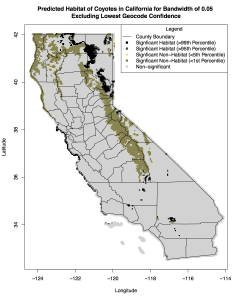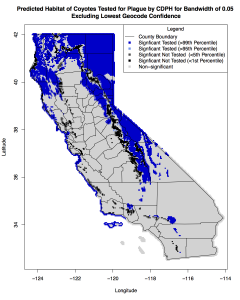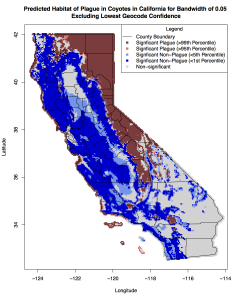My academic upbringing, undergraduate training, and community involvement stimulated a desire to participate in scientific research and instilled in me a strong commitment to two professional goals:
- To be a leader in infectious disease ecology, focusing on the intricate relationships between the environment, hosts, and pathogens
- To be a liaison between the fields of disease ecology and public health for efforts, to coordinate research efforts, and inform policy
Dissertation Research
|
|||
| Emerging infectious diseases (EIDs) burden global public health and economies originate from animals. Surveillance is essential to assess and ultimately control this type of disease called zoonoses. Control efforts for some diseases transmitted human to human by insect vectors have sophisticated surveillance networks that provided accurate identification of areas of human infection. However, surveillance can be imperfect and a challenge for zoonoses that are caused by pathogens transmitted from animals to humans, including Yersinia pestis, the causative agent of the plague. Past research has mapped human plague cases in the United States but have not used animal plague cases to predict the risk of human plague infection because of a suspected surveillance bias for animal cases. My dissertation investigates this bias and assesses the accuracy and utility of animal plague case data to predict human risk of plague infection in the United States by using data simulations and novel spatial modeling techniques. The goal is to provide better estimates for patterns of human plague risk in the US under future demographic and climate projections, which can direct prevention and control efforts. |
Previous Research Experience
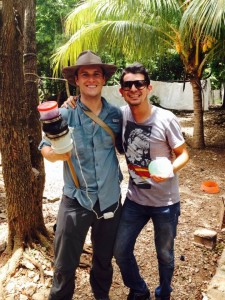 |
Research Rotation #3 – Dr. Vazquez-ProkopecMosquito species are becoming increasingly resistant to common pesticides, including the main vector for viruses, Aedes aegypti. Vector control programs are the mainstay of mosquito-borne disease, especially for Dengue and Zika viruses because there are no vaccines or antiviral treatments available. Pesticide resistance is a major concern for disease control programs around the world, particularly in cities, which have a high density of susceptible human hosts and ideal environments for mosquito vectors. In order to design better vector control programs, understanding how environmental variability affects the flow of genes for pesticide resistance within and between urban populations of mosquitoes has become a pressing area of research. In the picture, a prokopack adult mosquito aspirator (Patent #: 20110088309) on the left, fellow student Marco Torres-Castro on the right. |
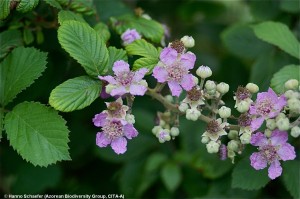 |
Research Rotation #2 – Dr. QuaveMany bacterial infections, including the problematic Staphyloccus aureus, are expressing strains resistant to common antibiotics and ones that produce a biofilm. New therapeutic treatments aim at inhibiting biofilm creation by using novel antibiotics, synthetically or naturally derived. One new method takes the latter approach by using a mixture of compounds found in roots of the native Mediterranean shrub Rubus ulmifolius (Elmleaf blackberry). A recently study by Quave et al. (2012) showed the synergistic activity of multiple compounds within the mixture, 220D-F2, was successful in limiting biofilm production of resistant strains of S. aureus when combined with different common antibiotics. However, the identification of the chemical constituents within the 220D-F2 mixture and the optimum combination of constituents for the observed therapeutic effect have yet to be discovered. |
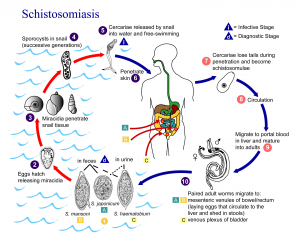 |
Research Rotation #1 – Dr. RemaisAn Ecology and Evolution of Infectious Disease (EEID) National Science Foundation grant resubmission (co-PIs: Dr. Justin Remais – UC-Berkeley and Dr. Jason Rohr – University of Southern Florida) titled “Predicting the effects of agricultural expansion and intensification on schistosomiasis transmission in Senegal: implications for sustainable agriculture” was resubmitted in 2014 and accepted in 2015. I developed the disease compartmental mathematical model and a table of known or investigated parameters for the computational portion of the grant. The grant is $2.5 million over 5 years. (Photo from CDC) |
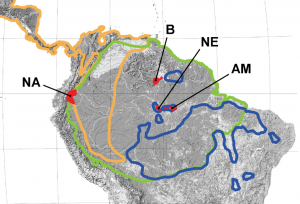 |
Estimating Occupancy and DetectabilityPrevious studies have assumed that an organism is truly absent from sites where it is not detected, which can result in some sites misleadingly appearing to be “unoccupied”. Occupancy models are used to estimate detection and occupancy probabilities using repeated-survey data and maximum likelihood or Bayesian methods. One common problem of maximum likelihood occupancy models is that convergence failures can arise when a key covariate bifurcates the observation data and drives the occupancy estimate to infinity, precluding further analysis. Currently there is no established statistical protocol to resolve this problem. In collaboration with Dr. Fernando Abad-Franch at Instituto Leônidas e Maria Deane – Fiocruz Amazônia, a modified version of the Occupancy models in the r package unmarked can be utilized. Dr. Abad Franch came across this issue in his 2010 publication (photo credit from same paper). |
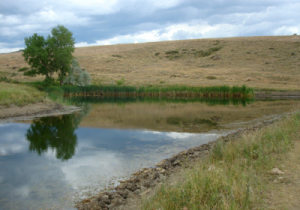 |
Parasite Species RangesThe study of species ranges is an active area of research asking the ecological question: Why do species occur in some locations and not others? Built and natural environments have a large influence on abiotic and biotic processes such as the type and abundance of human-cohabitating species including disease vectors and the pathogens they transmit. A species’ range is governed by myriad biotic interactions involving competitors, predators and pathogens as well as abiotic gradients. Many previous distributional studies have focused on free-living species, but there is a need to consider parasitic species ranges because they represent an interesting case study in having a high degree of biotic and abiotic requirements to complete their lifecycle. Theoretically, parasites that reside within a host should match their host ranges, although this may not be true for parasites that require multiple hosts. Moreover, if a parasite has a free-living stage then the parasite is exposed to the environment. My masters thesis used Alaria spp. to study this concept. |
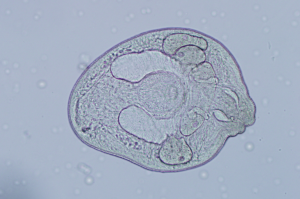 |
Biotic and Abiotic Determinants of Parasite PopulationsCurrently, there is no agreement whether local or regional variables structure ecological communities. This is a matter of spatial scale. Three separate schools of thought on this issue claim that (i) only local scale variables structure communities, (ii) only regional scale variables, such as the distribution of species in space through time, structure communities, especially for highly dispersive species such as migratory animals, and (iii) that a combination of both scales structure communities. Before addressing parasite communities, individual parasite species population need to be understood. Using the prevalence and abundance of parasites within the flatworm genus Alaria and their environmental variables: 1) How do patterns of Alaria infection vary with host biology?, 2) What is the spatial distribution of Alaria infection in amphibian hosts?, and 3) What are the environmental variables correlated with Alaria infection in amphibian hosts? |
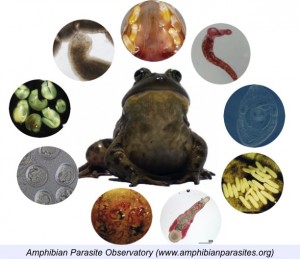 |
Amphibian Parasite ObservatoryInfectious disease is one of the major driving forces behind global amphibian declines. Amphibians are assaulted by a variety of pathogens, including fungi, flatworms, tapeworms, roundworms, bacteria and various protozoa. As such, amphibians offer a valuable model system to explore how environmental change affects infection prevalence and abundance of different pathogens. However, there was no single location to readily access information on the diversity of amphibian parasites. Therefore, along with Dr. Johnson, I created the first version of the website (link) presenting the entire data on the community of parasites identified in amphibians across North America collected by the Johnson lab, now called The Aquatic Parasite Observatory. At its creation, the Johnson Lab has assembled the largest amphibian parasite database, with well over 150,000 examined parasites from >30 amphibian species representing 37 US states. (Photo from Dr. Pieter Johnson) |
